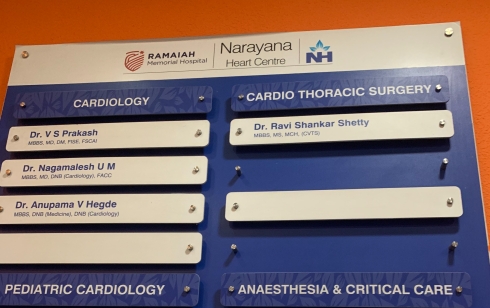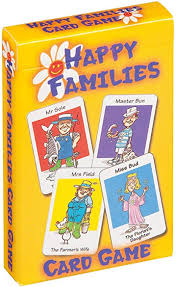
Narayana Heart Centre at M S Ramaiah Memorial Hospital
We moved houses a few months ago, and I needed to go to a completely new hospital for a check up. Imagine my surprise (and relief actually), when I saw the Cardiac Care department at M S Ramaiah, a large, old and reputed Hospital and Medical College, run by – Narayana Hrudayalaya, also a large, reputed and old Cardiac Care Hospital started by the eminent Dr. Devi Shetty! Now, this was a hospital I was very familiar with. It was hugely reassuring to get my check ups done there – and even see the familiar blue saree for the customer service folks – almost like being home.
It set me thinking about the world now collaborating in newer ways, even with erstwhile competitors, in a bid to win access to customers. (I saw later that the Oncology centre at Ramaiah was run by HCG, a cancer specialist).
Narayana itself, from being headquartered almost outside of Bangalore in a large “health city’, has of late started smaller branch centres all over at least south and south east Bangalore. And now, this shop in shop in Ramaiah!
So this is smart business, right, exemplifying a few business imperatives:
A) Core competency specialisation
B) Outsourcing of non core work to other experts
C) Competition changing to Co-optition (or, everything being fair in love, war and business)
And right then, I saw pop up on my screen, an ad for a sale at Nykaa, an online turned clicks and mortar retailer of beauty and personal care products (a retailer that my teenage daughter had first told me about some 4-5 years ago as her friends were all buying discounted toiletries and make up from there), of products by Fable Street, another online retailer that sells very attractive work wear clothes and accessories (this one run by an IIM alumna).
It kind of messed with my brain for a bit (I mean, I understand cross usage of channel, but direct competitors using each other as channels?), till I reasoned that this was the true value of the market place model that Amazon had pioneered. (An article I read recently put the figure of third party sales from Amazon at 58% of total revenue). This is Amazon’s stated intent of “helping independent retailers meet the needs of Amazon customers around the globe”. I think Amazon really made the transition from an e-tailer to a channel provider to a technology company very very smoothly and logically.
So what scenarios work best for this co-optition, or collaboration amongst competitors:
A) Multi party Industry nature collaborations
This is normally for Big Problems – setting standards/ fighting common causes like climate change/ defence and security/ energy/ epidemics/ education/ poverty.
For example, at the recent NRF 2020, one of the biggest panels featured executives from Target, Chipotle, and Best Buy who discussed the power of cyber security industry collaboration.
Or, in 2013/14 post the Rana Plaza disaster in Bangladesh, consortiums were formed between Walmart, H&M, Zara, Nike, Adidas to ensure safety and better working conditions for their workers
Open source was probably the earliest version of this co-optition – where varying competing organisations would come together for development.
IOT is a great area nowadays which needs to see, and is slowly seeing, collaboration between competitors to develop platforms and utilities for seamless customer experiences. Recently, Google, Apple and Amazon, probably the most acrimonious competitors amongst tech giants, unveiled a smart home collaboration, Connected Home over IP. This is inviting device manufacturers, silicon providers and developers across the smart home industry to join and develop new connectivity standards.
Another area is self drive cars – the trio of Ford, GM and Toyota has formed what they are calling the Automated Vehicle Safety Consortium
Ofcourse, when competitors work together, data security/ patent protection become critical areas, and most companies work well on solving for those. In case of any leaks, these collaborations dissolve.
B) Collaboration between select parties to develop new technologies/ products; to address client needs, or to fight a common competitor:
Probably the most celebrated example of co-opetition success is the 2004 Sony-Samsung JV to develop and produce LCD panels for flat-screen TVs. “Bravia” and “Bordeaux” came out of this collaboration, more than doubling the combined market share of these two companies.
In 2012, Harvard University and MIT formed EDX, a non-profit organisation that provides free online courses, each investing $US30 million. By end 2019, there were about 20 million students that it had served.
In 2017, a consortium of automakers including Ford, Toyota and Suzuki, planned to develop standards for in-vehicle car telematics as an alternative to Google’s Android Auto and Apple’s CarPlay.
In 2016, Facebook, Amazon, Google, IBM and Microsoft came together to create a historic partnership on AI. Apple, Google, Facebook, participated in a twitter data sharing project in 2019. Google supported Mozilla (Firefox web-browser), a rival to Google Chrome, in order to limit the expanding influence of Microsoft Internet Explorer and Apple Safari. At Samsung’s Galaxy Unpacked event in Aug 2019, the company announced four partnerships – of which Microsoft was one, to bundle its Android apps on the Note 10.
Even in the B2B world of tech services that I was briefly a part of, one has seen big competitors work together to win a large contract. TCS in 2018 was in talks with Wipro and Infosys to market its automation software Ignio, though nothing really fructified as Wipro ran the AI platform Holmes and Infosys its Nia.
In tech industries, the need for co-opetition is felt more due to the pace of evolution of technology, shorter life-cycle and high R&D costs. The cost of introducing new technology can be prohibitive for one company. Another perspective could be that these partnerships are short-term co-branding and marketing opportunities.
Pharma sees a lot of these in a bid to discover and trial new cures – In 2014, Pfizer and Merck collaborated on a study evaluating a novel Anti Cancer regimen. More recently, in 2019, Pfizer and Merck KGaA, joined BioXcel Therapeutics in its clinical collaboration with Nektar Therapeutics, creating a partnership to assess a triple combination therapy in pancreatic cancer. And then in 2020, Genome & Company entered into a clinical trial collaboration and supply agreement with Merck KGaA, and Pfizer to evaluate the safety, tolerability, biological and clinical activities of some combination therapies, in multiple cancer indications.
The risks of collaborating with rivals might seem huge but a study by the Multidisciplinary Digital Publishing Institute found that co-optition, when it lasted from three to five years, had more than a 50% chance of mutually reducing company costs.
But co-optition is not really new – There have been enough examples in History, as well as in ancient legends, mythology and fiction of strategic collaboration between enemies to defeat a rival enemy.
In India, the Rajputs occasionally united against foreign invaders – once under Bappa Rawal, then under Shakti Kumar of Mewar and Jaypal Tomar roughly in the 11th/ 12th century. Once the foreign invasions stopped, the Rajputs fought each other. Then, the rajputs under Rana Sanga managed to defend their confederation against Sultanates of Malwa, Gujarat and also Ibrahim Lodi, Sultan of Delhi.
Some historians think that Rana Sanga also invited Babur to fight against Ibrahim Lodhi, plotting that he himself would move over to Delhi after both warring sides were weakened. As it happened, Babur was very strong, he defeated Rana Sanga, and started the Mughal Dynasty.
Globally, while the US and the Soviet Union had not exactly been friends in the times before the WWII, it was their collaboration as allies that had a large part in defeating Nazi Germany.

Hagrid Looking at the Giant Colony
Recent popular fiction e.g. Harry Potter, saw both the Dark Lord’s side and the Order of the Phoenix wanting to ally with the giants to defeat the other side (this despite a fair degree of mistreatment accorded to the giants ordinarily by both sides). Ultimately, the Giants joined the Death Eaters. In the famous Game Of Thrones, Starks, Arryns and Targaryens allied with a few key House of Lannister members like Tyrion and Jamie and fought against the White Walkers, the army of dead in the battle of Winterfell.
Why go so far – Indian Politics sees a lot of co-optition – in 2018, the Karnataka state assembly elections saw a farcical situation when the party with the majority (BJP) first claimed the right to form the government, but then had to resign as its two competitors (The Congress which actually had the least votes, and the JD(S)) formed a post poll alliance and staked claim – it is another matter that the government didn’t last very long.
Apparently, in the NASCAR world, co-optition means one racer helping another by working together to go faster until the last lap, before they start competing against each other.
In teen patti/ cards, one has side shows with a competitor in a group to ensure the larger enemy gets slain.

Side Show in Teen Patti
As the iconic Godfather line said, “keep your friends close, and your enemies closer”
C) Cost Optimization/ Capacity Sharing
Don’t even get me started about this – the hardware guys want to make software and vice versa, the gaming guys are making voice assistants and so on and so forth. And competitors supply parts and components to direct competitors while their finished goods are fighting for share of wallet! It’s all over the place, and hugely incestuous!
Apple and Samsung for heaven’s sake! While Samsung’s Galaxy and Apple’s iPhone are arch rivals, Samsung at the same time continues to be one of Apple’s main suppliers of screens.
Microsoft and Intel were “married” to each other for ever it seemed (their Wintel alliance) till the advent of mobile technologies created a split.
The Star Alliance network of competing airlines, which included Air New Zealand, Thai, United, Air China, Lufthansa and Singapore Airlines, to name a few, was established to save on logistics, marketing and ticketing costs . But we travellers benefitted also as can share loyalty points :).
Peugeot Citroen and Toyota used to have an arrangement to share components for their city cars to the extent that critics said it was one car with three names.
And then there is branding/ white labelling in retail, and actually tech services. Essentially everybody plays happy families in order to lower the burden of capital intensive businesses.

Happy Families / Vasudhaiva Kutumbakam
D) Arising from a partner eco system
Then there are the companies who are building entire eco systems – Salesforce was one of the earliest. Now there is Amazon Web Services. And the participants in these eco systems are competitors but benefit from the network. I mentor an AWS / cloud computing consulting services startup called Rapyder – they do good work, have a solid client base, and are growing excitingly. Obviously helped on by AWS. Don’t yet exploit the advantage of co-optition – but could very soon.
In the social impact sector, there are platforms like Lets Do Some Good run by my ex business partner. Her concept when she started was to weed out the inefficiencies of “random acts of kindness” (e.g., too much funding and CSR efforts going to a school close to many corporates, and none going to one a little distance away), and give small NGOs and ISR folks the ability to synergise their efforts. Cooperatives and marketplaces are other such instances – Social Alpha, as an example, has incubated a farmer cooperative called Farmveda, that has enabled better market access and profits directly to a network of farmers in the South of India. Similarly, a market place called Habba, run by RangDe, that enables artisans to sell and reap the benefits of their crafts. Many countries do this, e.g New Zealand enables its wine growers export their products – all constituents can be viewed as competitors, but in the cooperative model, they leverage a common entity to come together for “the greater good” and enjoy the benefits.
(As an aside, while the greater good, also known as win -win is a really praiseworthy ambition, it can have very dark results as we know – after all, Hitler convinced a vast population that homophobia of various kinds was for the greater good. In recent times, a good metaphor for Hitler has been Grindelwald of the Fantastic Beasts/ Harry Potter franchise. Anyway, this is a deviation…)

Grindelwald giving the Greater Good Speech
E) Access to a whole new world
This is the pure commercial/ channel play, cross sell to allow mutual benefit, ensuring ubiquity of a familiar brand. The online world made this possible – when instead of customers needing to go destination shopping (including for medical services – a la me going to Narayana), they expected manufacturers and service providers to come to them. The battle for access became fiercer – with players realising the benefit of selective partnerships to ensure visibility across forums – the power of decision then lay in the customer’s hand, influenced less by “location”, and more by other factors – it really became survival of the fittest.
Vimeo, a competitor to youtube one would have thought, allowed publishing of its videos to youtube (as well as others like Facebook/ Linkedin etc) via its “publish to social” feature – this maybe underlines Vimeo’s shift from a video content making company to one that is making tools for content makers and publishers.
Microsoft offers Xbox games via Xbox live – on Nintendo Switch – its a partnership that is mutually beneficial, though there are claims that it may be ending soon. (It started with Minecraft, and post that, despite ongoing “exclusives” for each platform, the gaming companies started collaborating for better access. Sony has less incentive for this partnership, but there is certainly cross play gaming going on).
SAP used to run Oracle database and Microsoft Office is available on Apple computers (Macs and iPads). Similarly, Apple and Amazon combine for Kindle – Apple has a kindle app for iPads, which one would think is counter intuitive. But this is because Apple needs content for its devices, while Amazon needs people to buy more and more (e) books. In this case, it is because the strategic imperatives are different for the competitors for the collaboration.
Samsung and Apple have tied up for TV services, an area where both have been slow to grow.
This cooptition also helps small scale companies scale up by pooling resources too (a bit like the cooperative model, but not wider/ multiparty). It’s a rising tide, that raises all boats.
Overall, there is a time, place and reason for competition, and then one for collaboration – and increasingly, as we are seeing, the same two people can be competitors or collaborators. The world is becoming one large happy family – the Upanishads called it Vasudhaiva Kutumbakam.
As Abraham Lincoln said, “Do I not destroy my enemies when I make them my friends?”, and (not to be outdone), Sigmund Freud said “an intimate friend and a hated enemy have always been indispensable to my emotional life…not infrequently…friend and enemy have coincided in the same person”
And as my daughter would say, Ma, duh! Frenemies!

